
* Following up the immensely popular T-6 Texan trainer of World War II, in the postwar period, the North American Aviation (NAA) introduced an improved derivative, the "T-28 Trojan". It was a standard trainer for the US armed services, and also served as a light attack aircraft, in the "air commando" role, and for US allies. Following the T-28, NAA developed a naval jet trainer, the "T-2 Buckeye", which trained generations of US Navy pilots. This document provides a history and description of the T-28 and T-2.
* After World War 2, in response to a US Navy requirement for the ubiquitous North American SNJ / Texan trainer, North American built two prototypes of the "XSN2J-1" tandem-seat trainer, with the company model number of "NA-142", with the first performing its initial flight on 15 February 1947. The XSN2J-1 was configurationally similar to the SNJ, being a low-wing all-metal monoplane with:
It noticeably differed from the SNJ by having a proper bubble canopy, instead of a framed canopy. The two section of the canopy slid back to open. The Navy trainer effort fell apart in 1948, mostly due to postwar defense cutbacks, and so the XSN2J-1 never went into production.
However, in that same year, the US Air Force (USAF) issued a requirement for a trainer -- and so NAA modified the NA-142 design into the "NA-159", with two "XT-28", originally "XBT-28", prototypes built. Initial flight of the first prototype was on 24 September 1949. Evaluations proving successful, a production order was placed the next year, 1950, with service deliveries of the "T-28A Trojan" soon following.
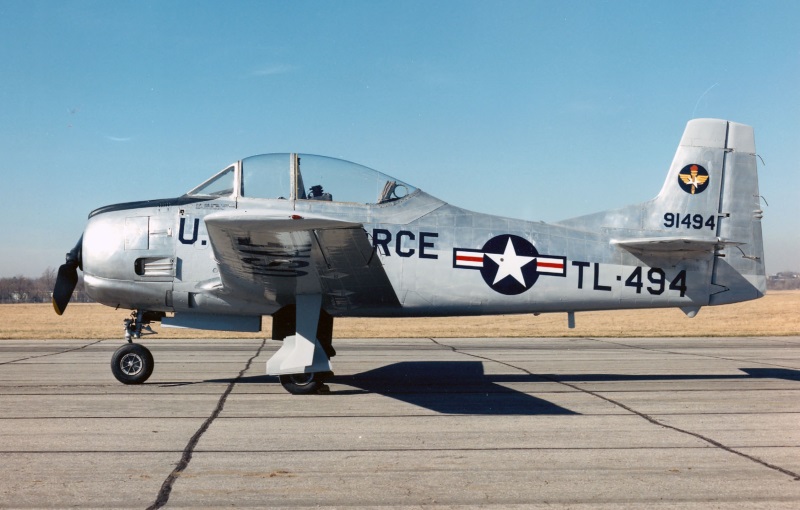
The T-28A was very similar to the XSN2J-1, being a low-wing monoplane with a radial engine, but differed significantly in having tricycle landing gear. The T-28A was powered by a seven-cylinder Wright R-1300-7, providing 600 kW (800 HP), driving a two-bladed Aero Products variable-pitch propeller. Due to some peculiarity of the engine exhaust configuration, the aircraft was somewhat noisy, with a "putt-putt" sound in flight. The crew sat in tandem under a bubble canopy, with two sections that slid to the rear to open. The crew did not have ejection seats. Early production had a taller canopy, and a roll-protection pylon, with a lower canopy and no pylon in later production.
Flight control surface arrangement was conventional, with one-piece flaps, ailerons, elevators, rudder, and trim tabs. The control surfaces were manually actuated, except for hydraulically-actuated flaps. The steerable nose gear had a single wheel, and retracted backwards. Although the XT-28 prototypes had a hydraulically-operated belly speed brake, it was deleted in the production T-28A.
Fuel storage was in the wings. Early production had a fuel capacity of 474 liters (125 US gallons); later machines had a fuel capacity of 671 liters (177 US gallons). The Trojan could be fitted with a single stores pylon under each wing, typically for hauling a 12.7-millimeter (0.50-caliber) machine gun pod or practice bombs, plus a gunsight, for weapons training.
1,194 T-28As were built to the last deliveries in 1953, with the aircraft built at NAA plants in Inglewood CA; Downey CA; and Dallas TX. The Army used a few of them for aerial photography; some T-28As were also exported under military assistance programs to Argentina (36), Dominican Republic (3), Ecuador (10), Honduras (6), South Korea, Mexico (80), and Nicaragua. Ten were to be provided to Cuba, but most or all were embargoed in Miami when Fidel Castro took over the country.
* The "T-28B" variant was acquired by the US Navy and Marine Corps, with this variant having a three-bladed prop; a belly speed brake; and a much more powerful Wright R-1820-9 radial engine, with 1,065 kW (1,425 HP) -- the R-1300 radial being perceived as underpowered, the T-28A having had sluggish climb performance. Along with the three-bladed prop, another distinguishing characteristic was a smaller nose wheel. Two T-28As were converted as prototypes.
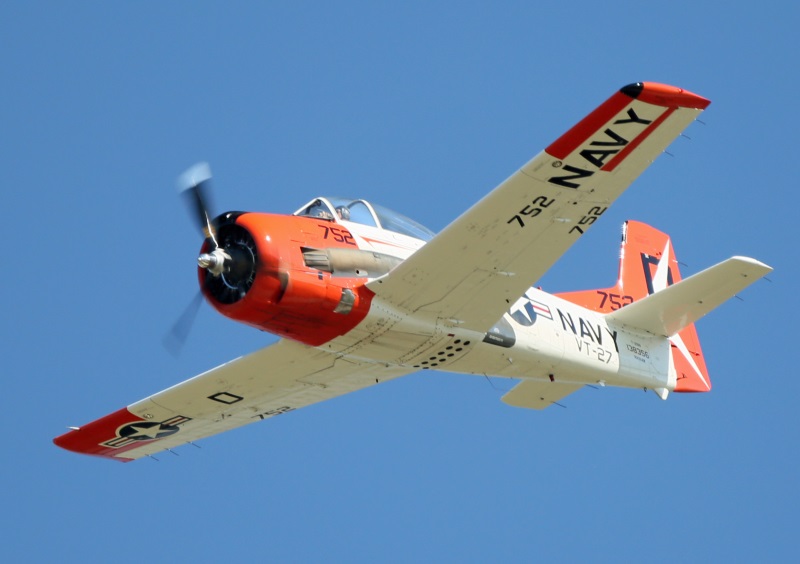
489 T-28Bs were built, with 17 conversions from T-28As as well. A single "RT-28B" kitted up for the reconnaissance role was supplied to the Japanese Air Self-Defense Force. Some of the US Navy T-28Bs were kitted up as drone controllers, designated "DT-28B", originally "T-28BD". They often flew with machine-gun pods to shoot down drones that "slipped the leash". The Air Force also received some T-28Bs for training, while the Army replaced their T-28As with T-28Bs.
In addition to the T-28Bs, the Navy acquired 299 "T-28C" machines for carrier training, these aircraft having a reinforced airframe, longer-stroke landing gear, an arresting hook, and shorter prop blades. Two T-28Bs were converted as prototypes, with dozens of conversions to full T-28C configuration from T-28As and T-28Bs as well. That gave a total of 2 + 1,194 + 489 + 1 + 299 == 1,985 production T-28s in all, with final production rolled out in 1957. Some sources claim that 1,948 were actually built, suggesting some upgrades being counted as new production.
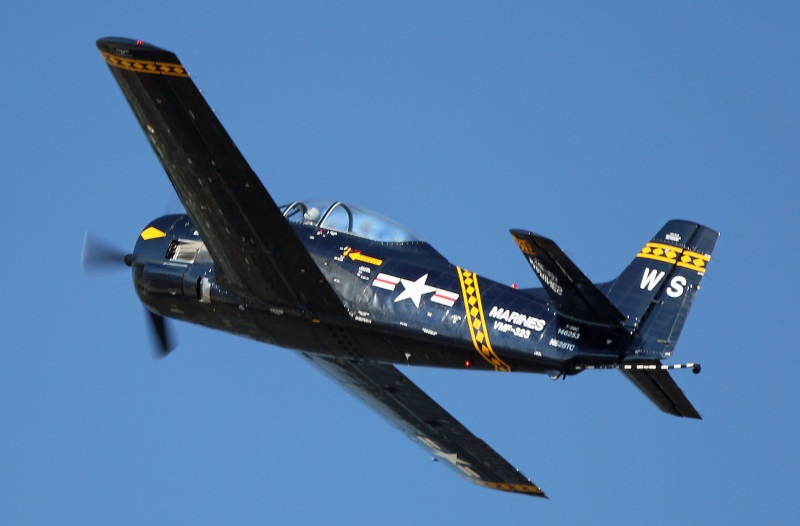
The Air Force phased the T-28A out of service as a primary trainer from 1956, replacing it with the Beech T-34 Mentor and Cessna T-37 -- but the Navy and Marines retained it in that role into the early 1980s. The last T-28 in formal US military service was phased out in 1984.
BACK_TO_TOP* The T-28 proved very useful as a counter-insurgency (COIN) aircraft. In the early 1960s, Fairchild and Pacific Airmotive ("Pac Aero") converted 79 and 321 T-28s, respectively -- for a total of 400 -- to "T-28D" configuration. The Pac Aero machines were given the name of "Nomad". The T-28Ds had a reinforced wing with six stores pylons; reinforced landing gear; some armor; a reflector gunsight, and armament control panel; and the Stanley "Yankee" ejection system. The Yankee was not an ejection seat; it was a rocket that fired upward, "yanking" the pilot out of the cockpit via a harness. It sounds like it was exciting to use, if not necessarily in a good sort of way.
T-28Ds were powered by the Wright R-1820-56S radial, with 970 kW (1,300 HP); or the -76A engine variant, with 1,065 kW (1,425 HP); or the -80 variant, with 1,145 kW (1,535 HP). Pac Aero machines with the different engine variants were named "Nomad I", "Nomad II", and "Nomad III", respectively. Total external warload was up to 1,360 kilograms (3,000 pounds). Typical stores were a 12.7-millimeter (0.50-caliber) Browning machine gun in a pod under each wing, plus offensive ordnance including napalm tanks, fragmentation bombs, unguided rocket pods, and cluster-munition dispensers. The late "T-28D-5" conversions had ammunition storage in the wings, not in the gun pods.
___________________________________________________________________
NORTH AMERICAN T-28D TROJAN:
___________________________________________________________________
wingspan:
12.22 meters (40 feet 1 inch)
wing area:
24.9 sq_meters (268 sq_feet)
length:
10.06 meters (33 feet)
height:
3.86 meters (12 feet 8 inches)
empty weight:
2,915 kilograms (6,425 pounds)
MTO weight:
3,855 kilograms (8,500 pounds)
max speed:
550 KPH (345 MPH / 300 KT)
service ceiling:
10,800 meters (33,500 feet)
ferry range:
1,705 kilometers (1,060 MI / 920 NMI)
___________________________________________________________________
The T-28Ds were flown by the USAF in Southeast Asia in the "Air Commando" role, with the "Farm Gate" detachment of the 4400 Combat Crew Training Squadron. The Air Commandos were officially there to train the South Vietnamese, they and were required to carry a South Vietnamese observer in the rear seat to maintain the story that the Americans were in a military advisory role, though the back-seater was often just "along for the ride".
The Farm Gate detachment helped bring up several South Vietnamese T-28D squadrons. Some of the South Vietnamese machines were kitted up for photo-reconnaissance, with a camera pack on the belly behind the wing, where the speed brake normally was, being at least informally designated "RT-28D".
USAF Captain Robert L. Simpson and a Lieutenant Hoa were shot down by ground fire on 28 August 1962, both crew being lost. Simpson was the first US air casualty of the conflict. The Air Commando T-28Ds were withdrawn in 1964-65, having suffered losses from ground fire, and also from structural failures. They were replaced by the Douglas A-1E Skyraider.
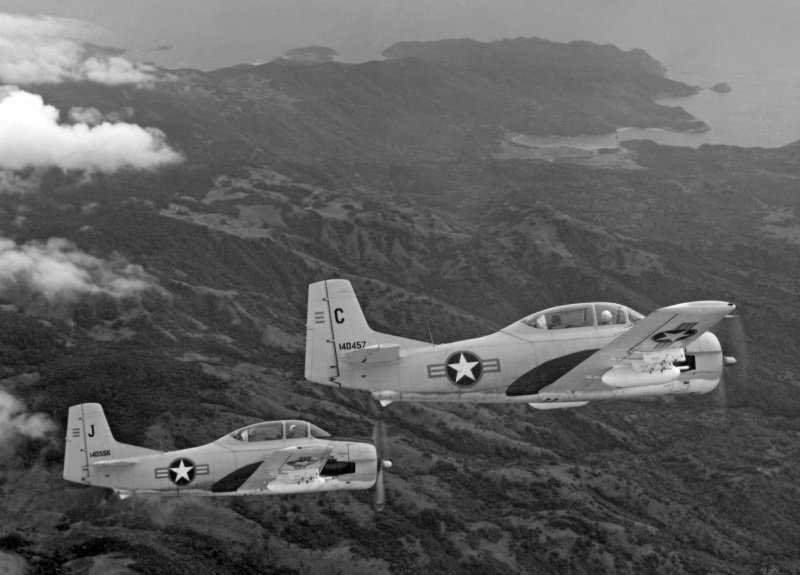
The Air Force continued to fly T-28Ds from Thailand, to perform attacks in Laos and Cambodia, these machines being finally withdrawn in 1972. T-28Ds were also passed on to Cambodia, Laos, and Thailand. T-28s were passed on to a number of other export users, including Bolivia, Brazil, the Democratic Republic of the Congo (Zaire), Cuba, Dominican Republic, Ecuador, Ethiopia, Honduras, Mexico, Nicaragua, the Philippines, South Korea, Saudi Arabia, and Taiwan.
Hamilton Aircraft refurbished a number of T-28s into two "Normair" variants:
* The French also used the T-28 in the close-support role -- but they weren't T-28Ds, they were 148 used trainer airframes obtained from Pac Aero, and modified by Sud Aviation in France. They had some armor, four stores pylons, and a Wright R-1820-97 radial engine, driving a three-bladed Hamilton Standard propeller; the cockpit and controls were also modified to conform to French standard, for example with reversed throttle. These machines were designated "T-28S", it appears because the engine was supercharged. Some sources also mention that they were at least informally given a "T-28F" designation, the "F" standing for "France".
They could be distinguished from other T-28 models by a little airscoop on the nose in front of the windscreen. They had underwing pods with twin 12.7-millimeter Brownings in each, with 100 rounds per gun. They were given the name of "Fennec", after the big-eared little desert fox. They fought in the Algerian War in 1960 and 1961. The conflict ended in 1962, with some of the Fennecs then disposed of, the rest being out of French service by 1967. 99 of the Fennecs were obtained by Argentina, and 25 obtained by Morocco. Numbers of these machines were eventually passed on to Haiti, Honduras, Nicaragua, and Uruguay.
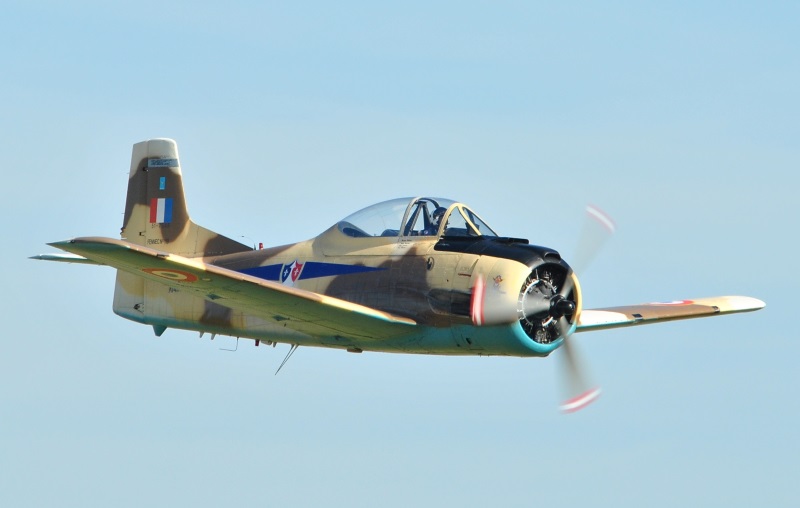
Many retired T-28s were subsequently sold to private civil operators. One T-28A was ruggedized to fly as a weather research aircraft for the South Dakota School of Mines & Technology, with funding from the National Science Foundation. It flew in this role from 1969 to 2005. Due to their reasonable operating costs, T-28s are often found flying or displayed as warbirds today. Some being flown in French Fennec colors are not Fennecs, instead being other T-28 models in disguise.
BACK_TO_TOP* The T-28 was an excellent aircraft, but its radial engine was behind the times. As a consequence, North American converted three T-28As into turboprop-powered T-28D-type close-support machines. These "YAT-28E" machines were powered by a Lycoming YT-55L-9 turboprop providing 1,825 kW (2,445 HP), driving a four-bladed paddle propeller. Initial flight of the first prototype was on 15 February 1963. The first machine crashed a few months later, killing NAA test pilot George Hoskins.
The YAT-28Es had a 12.7-millimeter Browning gun in a gondola under each inner wing, and six stores pylons under each wing, plus a wingtip rail for a Sidewinder air-to-air missile. They had an internal fuel capacity of 948 liters (250 US gallons), and could carry a 417-liter (110 US gallon) drop tank on each inboard stores pylon. Total external load capability was 2,730 kilograms (6,000 pounds).
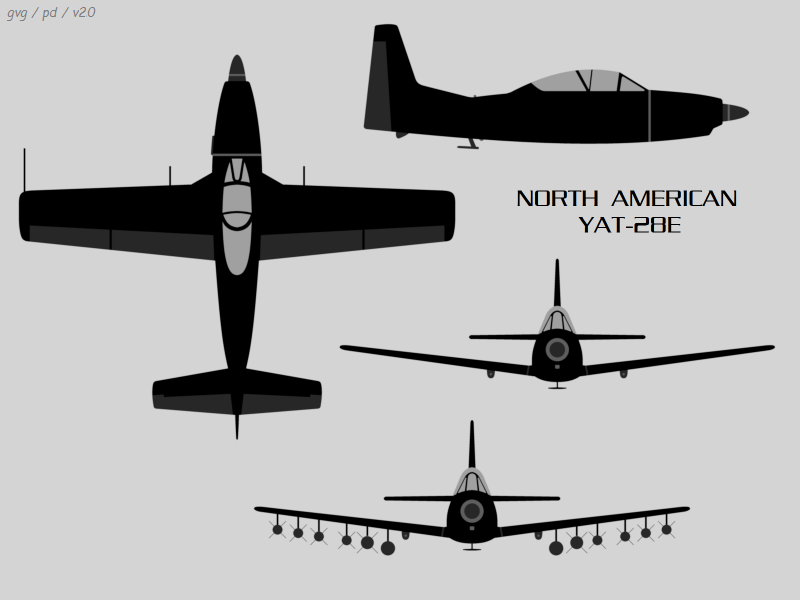
In final configuration, the YAT-28E had NAA LW-2C ejection seats with a modified canopy, and a taller tailfin to compensate for the canopy. The program did not go smoothly, while the introduction of the North American OV-10 Bronco and Cessna T-37 Dragonfly made the YAT-28E redundant. The program was canceled in 1965.
However, AIDC of Taiwan did produce a more modest turboprop version of the T-28 as the "T-CH-1 Chung Hsing", with a Lycoming T53-L-701 turboprop providing 1,080 kW (1,450 HP). Initial flight of the first prototype was on 23 November 1973, with 50 production machines built for the Republic of China Air Force from 1976 to 1981. The standard T-CH-1 had a light attack capability; some were flown as "A-CH-1" weapons training aircraft, while a number were kitted up for reconnaissance, and designated "R-CH-1".
In the early 1970s, the Volpar company of Van Nuys, California, proposed a twin-engine turboprop conversion of the T-28, with the Volpar "A-28F" to be powered by a Garrett TPE-331-3U turboprop, providing 675 kW (905 HP) on each wing. It would have had various options to be specified by the customer -- ejection seats, armor, various fuel tank arrangements -- plus six stores pylons, like the T-28D. The A-28F's most interesting feature was a modular, detachable nose, which allowing fit of different noses, such as a gun nose -- with four 12.7-millimeter machine guns -- or a photo-reconnaissance nose with cameras, or an electronic warfare nose. There wasn't much interest in the A-28F, and it never went beyond the paper stage.
BACK_TO_TOP* In 1956, the US Navy issued a requirement for a carrier-capable jet trainer, with US aviation companies submitting proposals. North American won the contest with its "NA-213", with six "YT2J-1" evaluation machines ordered. Initial flight of the first machine was on 31 January 1958, with Richard Wenzell at the controls, and introduction to service of the production "T2J-1" late in the next year, 1959. By that time, the type had acquired the name "Buckeye" -- that being the state tree of Ohio, the type being manufactured in NAA's Columbus plant.
The T2J-1 was of all-metal construction, and of "pod & boom" configuration -- with a single engine under the fuselage, with split intakes under the nose and the exhaust underneath the tail. It had mid-mounted tapered wings with fixed tip tanks, a swept tailfin with a prominent forward fillet, and a modestly-swept tailplane mounted up on the tailfin. Flight control surfaces were of conventional configuration, including ailerons, large single-piece flaps, elevators, and rudder, with trim tabs. The flight-control surfaces were hydraulically-driven, except for the manual rudder and trim tabs. There was a hydraulically-driven airbrake on each side of the rear fuselage.
The T2J-1 had hydraulically-actuated tricycle landing gear, all assemblies with single wheels, and a stinger-type arresting hook under the tail. The aircrew sat in tandem, the instructor in the rear, both sitting under a single canopy that hinged upward from the rear. The aircraft was powered by a single Westinghouse J34-WE-46/48 turbojet with 15.1 kN (1,540 kgp / 3,400 lbf) thrust. Fuel capacity was 2,430 liters (640 US gallons), in wing and tip tanks; it isn't clear if the tip tanks were removeable, but it seems they were never removed.
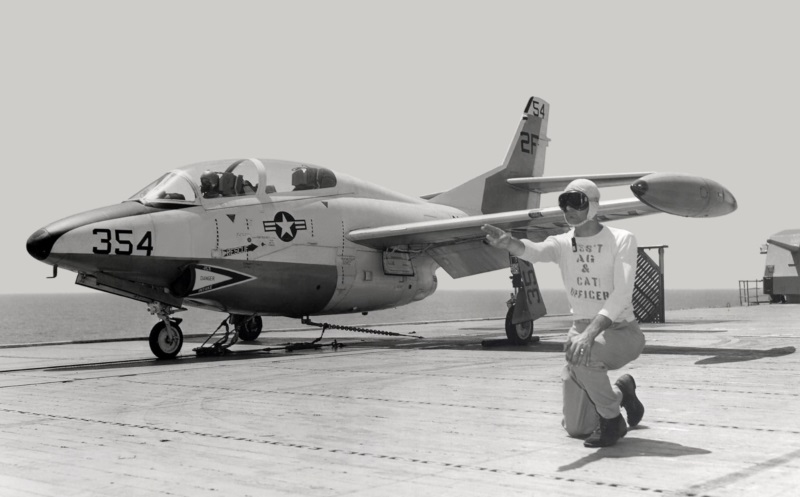
211 production T2J-1s were built, not counting the six YT2J-1s. The J34 turbojet was clearly inadequate, lacking enough thrust and, it seems, not being all that reliable; it was an antiquated engine, only selected because there were no other powerplants available in that class. The Navy also did not particularly like single-engine carrier aircraft, for safety reasons. In early 1962, the Navy issued a contract to update the T2J design to twin engines. In that same year, the Pentagon acquired a multi-service designation scheme, with the T2J-1 becoming the "T-2A".
Initial flight of the first twin-engine "YT-2B" -- a conversion from a T-2A -- was on 30 August 1962; sources hint there was a second conversion. The pod-&-boom configuration make updating to two engines relatively straightforward: instead of a single engine on the belly, two engines were installed side-by-side. The intake configuration remained the same, though the intakes were enlarged to handle more airflow. The engines were Pratt & Whitney J60-P-6 turbojets with 13.3 kN (1,360 kgp / 3,000 lbf) thrust each.
Avionics were generally updated as well. Later production had fuel tanks in the wing leading edge, increasing fuel supply by 190 liters (50 US gallons). That increased fuel capacity to 2,620 liters (691 US gallons) in all. A total of 97 new-build T-2Bs was produced.
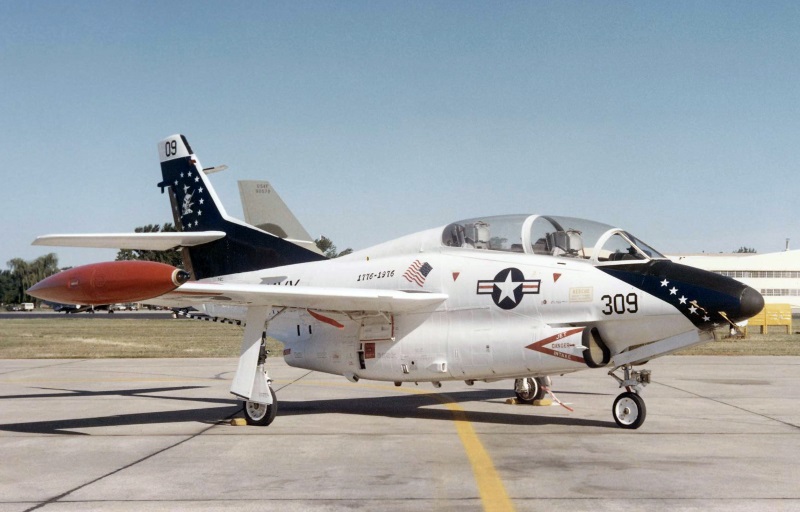
In 1967, the Navy decided to refit the T-2B with more robust, if slightly less powerful, General Electric J85-GE-4 turbojets, providing 33.1 kN (1,335 kgp / 3,000 lbf) thrust each. There were no other significant changes. The first "YT-2C", a conversion of a YT-2B, performed its initial flight on 17 April 1968.
___________________________________________________________________
NORTH AMERICAN T-2C BUCKEYE:
___________________________________________________________________
wingspan:
11.62 meters (38 feet 2 inches)
wing area:
23.7 sq_meters (255 sq_feet )
length:
11.67 meters (38 feet 4 inches)
height:
4.51 meters (14 feet 10 inches)
empty weight:
3,680 kilograms (8,115 pounds)
MTO weight:
5,980 kilograms (13,180 pounds)
max speed:
840 KPH (520 MPH / 455 KT)
service ceiling:
12,300 meters (40,400 feet)
range:
1,685 kilometers (1,045 MI / 910 NMI)
___________________________________________________________________
The T-2C had a single pylon under each wing, generally to carry a 12.7-millimeter machine-gun pod for weapons training. Practice bombs or a rocket pod could be carried instead. Presumably the T-2B had the weapons training capability as well; it's not so certain the underpowered T-2A did.
12 "T-2D" trainers were sold to Venezuela in 1972, with deliveries from 1977. In 1977, Venezuela ordered 12 more T-2Ds, these with an attack capability, with some armor protection, and three stores pylons under each wing, with a total external load capacity of 1,585 kilograms (3,500 pounds). 40 "T-2E" machines were sold to Greece, all with attack capability, being delivered in 1976 and 1977.
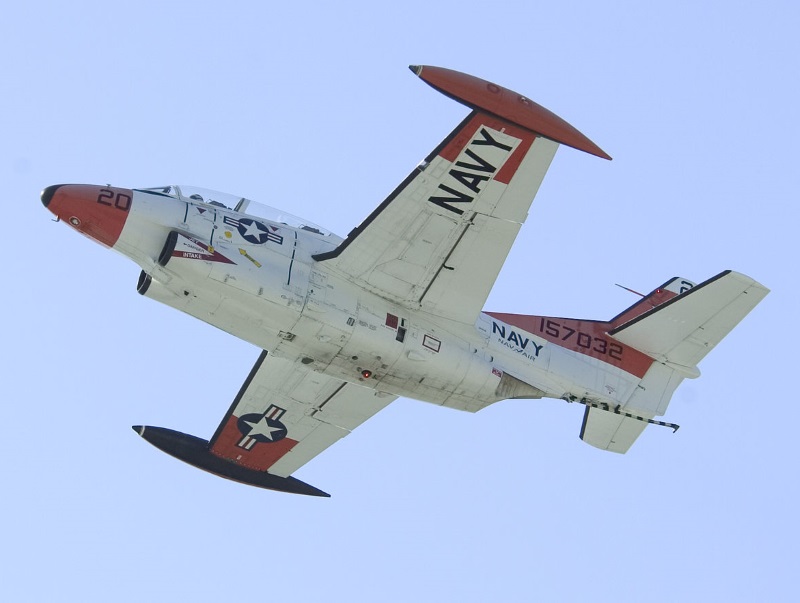
A total of 609 Buckeyes of all types was built to end of production. The T-2 was the standard jet trainer for the USN from the late 1950s to 2004, ultimately being replaced by the McDonnell Douglas T-45 Goshawk, a navalized derivative of the BAE Systems Hawk. Several Buckeyes were converted to "DT-2B / DT-2C" drone director aircraft. Some T-2s ended up in civilian hands, and do appearances at airshows.
BACK_TO_TOP* Sources include:
* Illustrations details:
* Revision history:
v1.0.0 / 01 jul 19 v1.1.0 / 01 may 21 / Review & minor corrections. v1.2.0 / 01 aug 22 / Review & polish. v1.2.1 / 01 apr 24 / Review & polish.BACK_TO_TOP
